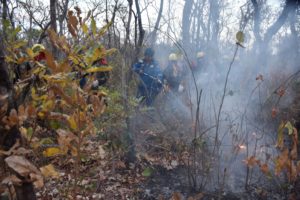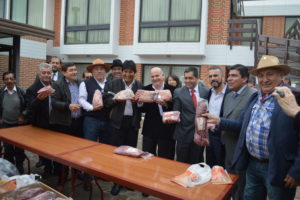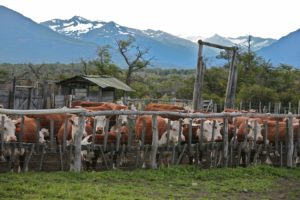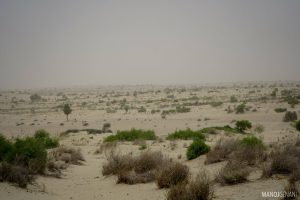“Two days ago, we dispatched the first shipment of beef to China. It is a guaranteed market, so we have an obligation to take care of our cattle, to expand cattle raising, not just the quantity, but quality too”, said Bolivian President Evo Morales on 30 August in Concepción, one of the municipalities affected by the fires that have been devastating more than a million hectares of forests and pastures in Bolivia.
Throughout August, forest fires occurred in eastern Bolivia and near the border with Brazil in parts of the tropical savannah region of Chiquitania and the region of Pantana which contains the world’s largest marshlands. They were caused mainly by the practice of slash-and-burn agriculture to prepare land for planting. There were ten municipalities affected in the department of Santa Cruz.
Despite the efforts of professional firefighters and volunteers, as of 1 September it has not been possible to control the fires, which are being reactivated by strong winds and heat. However, hot spots have decreased from 8,000 to 662 in less than 10 days, according to according to government reports.
The government has been criticised for failing to request international aid to address the problem at the outset, and for having authorised the expansion of the agricultural frontier to, among other priorities, promote the export of meat to China.
Although meat exports are not to blame, several researchers have argued that there may be links between the fires and the economic policies authorising the clearing of forests for agriculture, and to the awarding of state-owned lands to private individuals.
The fire of agribusiness
“The fire skipped from one side to the other. When the firefighters arrived to put it out in one area, we heard the news that it was back again somewhere else. All the manpower that could be mustered failed to control it”, says Rubén Darío Arias, a member of Tucabaca Valley’s defence platform, located in the municipality of Roboré in the Chiquitania.
The Tucabaca Municipal Forest Reserve was affected by the deforestation of 55 hectares when a community of 33 peasant families tried to settle within it, after obtaining authorisation from the INRA (National Agrarian Reform Institute), which is responsible for the distribution and titling of Bolivian public lands. Although agricultural activities go against the area’s conservation mandate, the families had clearing authorisation from the ABT (Forests and Lands Authority).
The fire began to spread in Santa Cruz in the second week of August. The affected area is occupied by small landowners (28% of titled lands), medium-size landowners (22%) large companies (35%), peasant communities (7%) and Traditional Communal Lands (collective indigenous or peasant properties), according to data from agrarian researcher Gonzalo Colque, Director of NGO the Land Foundation.
Colque stresses the fact that medium and large-scale businesses (which control 57% of the titled land in the region) are the major beneficiaries of the most dynamic land titling process.
Colque adds that the 7% owned by peasant communities is not a significant share. However, this figure fails to include new peasant communities that do not have titles but have already obtained authorisations to settle on state lands, which allow them to clear up to 20 hectares per family.
If they propose to expand the agricultural frontier by some 20 million hectares, it is obvious that we will have major fires
“They have obtained the right to vary the regulations regarding land use, mainly by clearing. The big question is, who are the beneficiaries of this land distribution, which is carried out without the due agrarian process that should culminate in land titling?”, Colque stresses.
“Preliminary figures (provided by the Land Foundation) show that most of the hectares burned would be public (state) lands and lands belonging to agricultural companies. Basically, we would be talking about 70%”, he said. The Land Foundation prepared a map that outlines this relationship.
The fires have also impacted regions of the Bolivian Amazon, mainly in the department of Beni and in places such as the Beni Biological Station, a national protected area. After four days of efforts, firefighters, park rangers, biologists and volunteers managed to control the fire. The risk has still not been eliminated though, with slash-and-burn methods persisting.
Forest or agro-industry?
It doesn’t just happen in Bolivia. Globally, there is a correlation between major fires destroying tropical forests and deforestation due to international demand for commodities such as soybeans, palm oil or meat, research biologist Vincent Vos states.
“If they propose to expand the agricultural frontier by some 20 million hectares, it is obvious that we will have major fires… This expansion will mean the death of billions of plants and animals. That is the proposal and that is what we are living with”, says Vos, who has lived in Beni for 20 years and works in Amazonian rural development.
He is not the only expert in Bolivia who wonders whether some economic policies are turning into detrimental incentives that facilitate deforestation.
The incentives for bioethanol production launched by the government of Evo Morales, which enabled the internal market for biofuel production (ethanol and biodiesel), are an attempt to stop Bolivia from importing fuels. But they also cause concern among environmental experts who fear that deforestation will increase.
“Agricultural development is no longer seen as a process oriented towards the production of food for the internal market and for the world, as the initial propaganda said, but rather for increasing crops that, like sugarcane and soy, are raw materials for the production of biofuel”, says Enrique Ormachea Saavedra, of the Centre for Labour and Agrarian Development Studies (CEDLA).
“During the 13 years of the Broad Social Movement (MAS) [Movimiento Amplio Social], a little more than 70% of the net increase in agricultural production is due to two crops”, adds Ormachea, who has just published an article titled “Concerning the environmental disaster in the Chiquitania. Expansion of the agricultural frontier or increases in land productivity?”.
Others fear that products such as ethanol will occupy space better used for food production. Miguel Ángel Crespo, director of environmental NGO Probioma, says: “Law 1098 establishes mechanisms to control deforestation and the displacement of other crops for the production of crops intended for the production of additives… That obviously means an admission… not to favour food sovereignty, but rather to benefit a sector that will produce an energy source (bioethanol)”.
No changes to the scenario
The spread of the fires has diminished somewhat, although as of 1 September they had not succeeded in extinguishing them all. In addition, the meteorological service forecasts winds which could stoke them.
Among the solutions touted by experts are declaring the fires a “national disaster” in order access international aid. For now, the Morales government has ruled this out, because it is confident that controlling the fires has not gone beyond the State’s capacity.
Experts also argue that a number of regulations allowing the expansion of agriculture into forested areas should be reconsidered.
Although [sales] will triple, these are figures that in no way justify the socio-environmental cost of expanding the agricultural frontier for meat exports.
That would seem to go against the government’s aims, however. In Concepción, President Morales said on Friday that the fundamental bases for Bolivia’s economic growth are “energy, hydrocarbons, mining, agriculture and scientific knowledge”.
“Export, export the surpluses. Now if we talk about China, we need quantity and quality… Bolivians must have access to sufficient meat, and the rest can be exported”, Morales said.
Crespo, from Probioma, proposes a restructuring of the entire agricultural development process, declaring an ecological pause, repealing all the regulations that have opened the doors to the extension of the agricultural frontier and carrying out an environmental audit to quantify the damage in order to work on restoration of the forests.
“Although [sales] will triple, these are figures that in no way justify the socio-environmental cost of expanding the agricultural frontier for meat exports. You must see what the forest means not only to Bolivia but to the world. It is about water, flora, fauna”, he says.
Bolivian meat is on its way to China
On 28 August, the Santa Cruz Cattlemen’s Federation (Fegascruz) sent the first 48 tons of beef to China, with plans to export 8,000 tons there in 2019.
Farmers currently have a surplus of 40,000 tons of meat for export and are targeting other new markets such as Russia. They expect to grow sustainably at 5% a year until 2030, which would generate a surplus of 200,000 tons of meat for export, according to Oscar Ciro Pereira, representative of Bolivia’s Livestock Confederation. That would mean an income of US$800 million for the country.
That expectation comes down to China being the world’s largest meat importer, with a per capita consumption of 60 kilogrammes of meat per year for its more than 1.4 billion inhabitants.
The Chinese ambassador, Liang Yu, announced that China plans to import US$10 billion in goods and services over the next few years, opening up possibilities for other Bolivian products. Bolivia exported mainly from small producers.
It is less clear how the country will be able to ensure these incomes for Bolivian agriculture without the loss of forest cover.
According to a study by Friends of Nature Foundation, an NGO, the livestock sector is responsible for 60% of deforestation in Bolivia. Research has detected an expansion in deforestation in regions like Charagua and the Chiquitania, both in the department of Santa Cruz, which accounts for 78% of the country’s deforestation.
Up until now, the government has not explained how they will reconcile support for the country’s agricultural sector with incentives such as the expansion of the agricultural frontier, without losing forest. The fires seen in the last three weeks in the Chiquitania and the Bolivian marshlands show the importance of this response.









